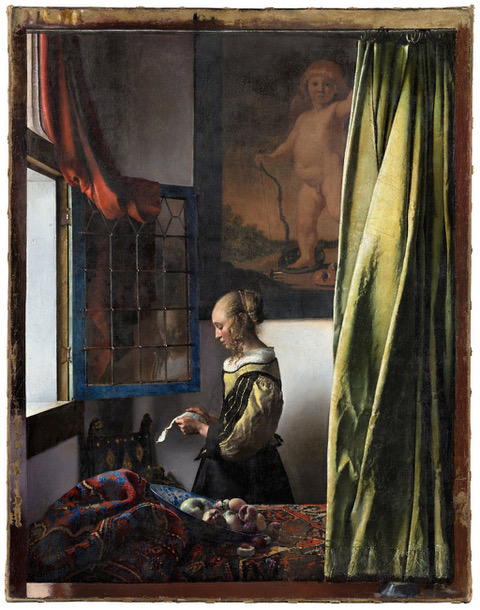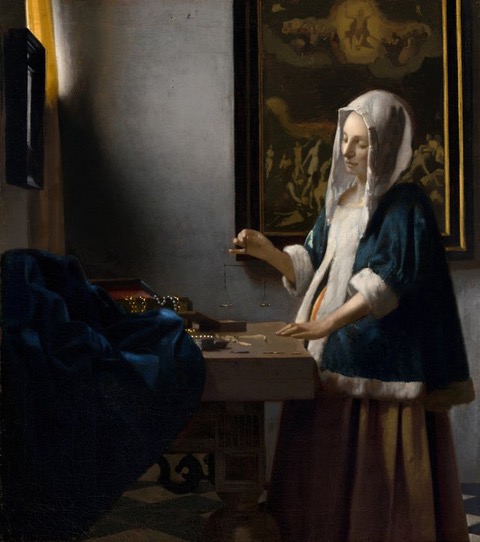Pause! See anew! Thinking about it …
Johannes Vermeer. On Reflection – On the exhibition in Dresden’s Gemäldegalerie Alte Meister
by Gisela Schlatterbeck-Kersten
When the exhibition of paintings by the Dutch painter Jan Vermeer was announced in the Dresden State Art Collections in March of this year, two things caught my attention.
To announce an exhibition – which would bring some hype – with the title “On Reflection”1 touched me deeply. In my student days, Vermeer’s painting “Dorfstrasse” (Village Street) in the Rijksmuseum in Amsterdam had occupied me intensely. I really had to pause when I came out of the big hall with the giant painting of Rembrandt’s “Night Watch”, because Vermeer’s relatively small-format paintings take time to decipher all the small-scale “messages” the painting offers.
On the other hand: Pause? Why?
One has to imagine: A painting that has been reproduced many, many times, about which many interpretations have been written, this “Letter-Reading Girl at the Open Window” is almost suddenly reinvented for the art viewer in the course of the restoration, is to be reinterpreted, brings to light many aspects about paintings and their history in general.
Someone, presumably after Vermeer’s death, had induced to paint over a detail that was perhaps disturbing or even offensive to him, namely a naked putto above the girl’s head. And today, when it is possible to X-ray a painting, it was clear: there had been an intervention, not by the painter himself, but later.
And experts discussed whether one should take the risk of undoing such an intervention. A commission decided to restore the painting “Letter-Reading Girl” to the state conceived by the painter.
It is impressive to follow this restoration process in videos.
Pause! Seeing anew! Thinking about what can now be seen, comparing it with other paintings by Vermeer, with paintings by colleagues, a show of works from the Golden Age of 17th century Dutch painting, now on display in the Gemäldegalerie Alte Meister (Art Gallery Old Masters) in Dresden.
It’s important to know that you have to get tickets for a time slot at which you’ll be admitted. The good thing is that the exhibition is never crowded, although you can stay as long as you like. It’s soothingly quiet there, the visitors considerately letting everyone stand in front of the paintings in peace.
The only bench is in the last room, here the painting “Letter-Reading Girl at the Open Window” has its place. There you are finally in front of the painting, of which you can see the close-ups of the restoration process and colour analyses in the anteroom.
The invitation to pause is especially directed at the paintings of Jan Vermeer. Most of the paintings have a hidden meaning. An educated viewer of the 17th century could probably decipher the meaning of the putto with a bow, who is still stepping on a mask lying on the floor. We today recognise a Cupid, but overlook the masks on the floor in the background of the painted picture. What are they supposed to mean? Masks serve the purpose of disguise, that is, of falsehood. So, the Cupid means love, he steps on the mask as falseness, so true love is probably meant.
Or in the image of the “Woman with the Scales”. She pauses until the gold scale is in balance. On the table you see pearl necklaces and gold jewellery. And again, a painting in the background: the Last Judgement, Christ as the Judge of the World. Then a meaning to be read along could be the question of justice, honesty or even charity. But these references are really only in the background. Each painting is a treasure.
There was one more interesting discovery: in some of the gilded frames I noticed a fine cut all around in the middle of the frame width, I even saw hinges and a tiny keyhole. When I asked the warden if this was an interchangeable frame, he explained, probably glad for the change, that the King, as owner of the collection, showed selected visitors some paintings without the pane in front to make the oil colours glow even more beautifully. •
Exhibition: Johannes Vermeer. On Reflection; 10 September 2021 to 2 January 2022 in the Gemäldegalerie Alte Meister (Art Gallery Old Masters) in the Zwinger Dresden – State Art Collections; Interesting is also the video: Die Restaurierung von Johannes Vermeers «Brieflesendes Mädchen am offenen Fenster». (The Restoration of Johannes Vermeer’s “Letter-Reading Girl at an Open Window”)
1 Translator’s note: “On Reflection” is the official English translation of the German title “Vom Innehalten” in Dresden; in German: “Innehalten” actually means “to pause” and is used several times in the article.

